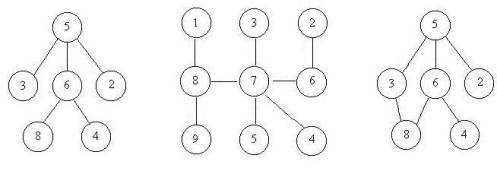http://acm.hdu.edu.cn/showproblem.php?pid=1272
Problem Description
上次Gardon的迷宫城堡小希玩了很久(见Problem B),现在她也想设计一个迷宫让Gardon来走。但是她设计迷宫的思路不一样,首先她认为所有的通道都应该是双向连通的,就是说如果有一个通道连通了房间A和B,那么既可以通过它从房间A走到房间B,也可以通过它从房间B走到房间A,为了提高难度,小希希望任意两个房间有且仅有一条路径可以相通(除非走了回头路)。小希现在把她的设计图给你,让你帮忙判断她的设计图是否符合她的设计思路。比如下面的例子,前两个是符合条件的,但是最后一个却有两种方法从5到达8。


Input
输入包含多组数据,每组数据是一个以0 0结尾的整数对列表,表示了一条通道连接的两个房间的编号。房间的编号至少为1,且不超过100000。每两组数据之间有一个空行。
整个文件以两个-1结尾。
整个文件以两个-1结尾。
Output
对于输入的每一组数据,输出仅包括一行。如果该迷宫符合小希的思路,那么输出"Yes",否则输出"No"。
Sample Input
6 8 5 3 5 2
6 4
5 6 0 0
8 1 7 3 6 2 8 9 7 5
7 4 7 8 7 6 0 0
3 8 6 8 6 4
5 3 5 6 5 2 0 0
-1 -1
Sample Output
Yes
Yes
No
题解:并查集
代码:
#include <bits/stdc++.h>
using namespace std;
const int maxn = 1e5 +10;
int f[maxn], A[maxn];
int N, M;
int cnt = 0;
void init() {
for(int i = 1; i <= maxn; i ++)
f[i] = i;
}
int Find(int x) {
if(f[x] != x) f[x] = Find(f[x]);
return f[x];
}
int Merge(int x, int y) {
int fx = Find(x);
int fy = Find(y);
if(fx != fy) {
f[fx] = fy;
return 1;
}
else return 0;
}
int main() {
while(true) {
init();
int num = 0;
bool flag = true;
while(~scanf("%d%d", &N, &M)) {
if(N == -1 && M == -1) return 0;
else if(!N && !M) break;
else if(flag) {
if(!Merge(N, M)) flag = false;
A[++ num] = N;
A[++ num] = M;
}
}
if(flag) {
for(int j = 1; j <= num; j ++) {
if(Find(f[A[j]]) != Find(f[A[1]]))
flag = false;
}
if(flag) printf("Yes
");
else printf("No
");
}
else printf("No
");
}
return 0;
}